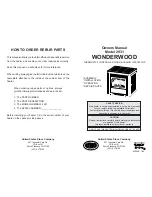
22
Failure to clean and maintain this unit as indicated can result in poor performance, safety hazards,
fire, and even death.
Unplug your stove’s electrical cord prior to removing the back panel or opening the exhaust system
for any inspection, cleaning, or maintenance work.
Never perform any inspections, cleaning, or maintenance on a hot stove.
Do not operate stove with broken glass, leakage of flue gas may result.
EXHAUST SYSTEM
Creosote Formation – When any wood is burned slowly, it produces tar and other organic vapors, which combine with
expelled moisture to form creosote. The creosote vapors condense in the relatively cool chimney
fl
ue or a newly started
fi
re or from a slow-burning
fi
re. As a result, creosote residue accumulates on the
fl
ue lining. When ignited, this creosote
makes an extremely hot
fi
re, which may damage the chimney or even destroy the house. Despite their high ef
fi
ciency,
pellet stoves can accumulate creosote under certain conditions.
Fly Ash – This accumulates in the horizontal portion of an exhaust run. Though non-combustible, it may impede the
normal exhaust
fl
ow. It should therefore be periodically removed.
Inspection and Removal – The chimney connector and chimney should be inspected by a quali
fi
ed person annually or
per ton of pellets to determine if a creosote or
fl
y ash build-up has occurred. If creosote has accumulated, it should be
removed to reduce the risk of a chimney
fi
re. Inspect the system at the stove connection and at the chimney top. Cooler
surfaces tend to build creosote deposits quicker, so it is important to check the chimney from the top as well as from the
bottom. The creosote should be removed with a brush speci
fi
cally designed for the type of chimney in use. A quali
fi
ed
chimney sweep can perform this service. It is also recommended that before each heating season the entire system be
professionally inspected, cleaned and, if necessary, repaired. To clean the chimney, disconnect the vent from the stove.
INTERIOR CHAMBERS
•
Burn Pot: Periodically remove and clean the burn pot and the area inside the burn pot housing. In particular, it is
advisable to clean out the holes in the burn pot to remove any build up that may prevent air from moving through
the burn pot freely.
•
Heat Exchanger: There is a clean out plate on both sides of the heat exchanger that need to be removed to clean
fl
y ash out of the heat exchanger. The cleanouts are located inside the cabinet doors, on the lower front corners of
the heat exchanger.
If a vacuum is used to clean your stove, we suggest using a vacuum designed for ash removal. Some regular vacuum
cleaner (i.e. shop vacs) may leak ash into the room.
DO NOT VACUUM HOT ASH
ASH DISPOSAL
Remove ashes when unit has cooled. Ashes should be placed in a metal container with a tight
fi
tting lid. The closed
container of ashes should be placed on a noncombustible
fl
oor or on the ground, well away from all combustible materials,
pending
fi
nal disposal. If the ashes are disposed of by burial in soil or otherwise locally dispersed, they should be retained
in the closed container until all embers have been thoroughly cooled. The container shall not be used for other trash or
waste disposal. If combined with combustible substances, ashes and embers may ignite.
SMOKE AND CO MONITORS
Burning wood naturally produces smoke and carbon monoxide(CO) emissions. CO is a poisonous gas when exposed
to elevated concentrations for extended periods of time. While the modern combustion systems in heaters drastically
reduce the amount of CO emitted out the chimney, exposure to the gases in closed or con
fi
ned areas can be dangerous.
Make sure you stove gaskets and chimney joints are in good working order and sealing properly to ensure unintended
exposure. It is recommended that you use both smoke and CO monitors in areas having the potential to generate CO.
CHECK AND CLEAN THE HOPPER
Check the hopper periodically to determine if there is any sawdust (
fi
nes) that is building up in the feed system or
pellets that are sticking to the hopper surface. Clean as needed.
MAINTENANCE
Summary of Contents for Ashley AP5770
Page 31: ...31 WIRING DIAGRAM ...














































